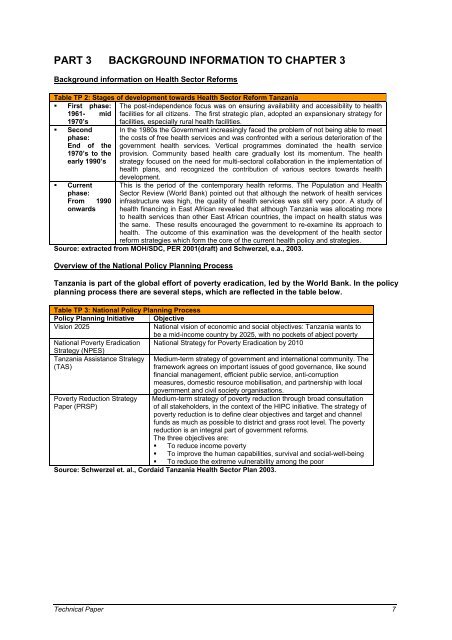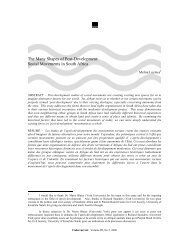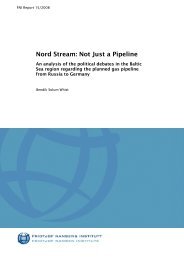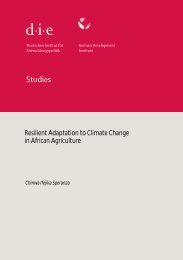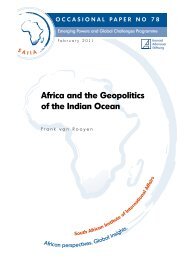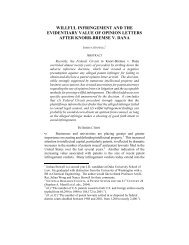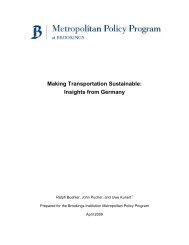equity implications of health sector user fees in tanzania
equity implications of health sector user fees in tanzania
equity implications of health sector user fees in tanzania
Create successful ePaper yourself
Turn your PDF publications into a flip-book with our unique Google optimized e-Paper software.
PART 3 BACKGROUND INFORMATION TO CHAPTER 3<br />
Background <strong>in</strong>formation on Health Sector Reforms<br />
Table TP 2: Stages <strong>of</strong> development towards Health Sector Reform Tanzania<br />
� First phase:<br />
1961- mid<br />
1970’s<br />
� Second<br />
phase:<br />
End <strong>of</strong> the<br />
1970’s to the<br />
early 1990’s<br />
� Current<br />
phase:<br />
From 1990<br />
onwards<br />
The post-<strong>in</strong>dependence focus was on ensur<strong>in</strong>g availability and accessibility to <strong>health</strong><br />
facilities for all citizens. The first strategic plan, adopted an expansionary strategy for<br />
facilities, especially rural <strong>health</strong> facilities.<br />
In the 1980s the Government <strong>in</strong>creas<strong>in</strong>gly faced the problem <strong>of</strong> not be<strong>in</strong>g able to meet<br />
the costs <strong>of</strong> free <strong>health</strong> services and was confronted with a serious deterioration <strong>of</strong> the<br />
government <strong>health</strong> services. Vertical programmes dom<strong>in</strong>ated the <strong>health</strong> service<br />
provision. Community based <strong>health</strong> care gradually lost its momentum. The <strong>health</strong><br />
strategy focused on the need for multi-<strong>sector</strong>al collaboration <strong>in</strong> the implementation <strong>of</strong><br />
<strong>health</strong> plans, and recognized the contribution <strong>of</strong> various <strong>sector</strong>s towards <strong>health</strong><br />
development.<br />
This is the period <strong>of</strong> the contemporary <strong>health</strong> reforms. The Population and Health<br />
Sector Review (World Bank) po<strong>in</strong>ted out that although the network <strong>of</strong> <strong>health</strong> services<br />
<strong>in</strong>frastructure was high, the quality <strong>of</strong> <strong>health</strong> services was still very poor. A study <strong>of</strong><br />
<strong>health</strong> f<strong>in</strong>anc<strong>in</strong>g <strong>in</strong> East African revealed that although Tanzania was allocat<strong>in</strong>g more<br />
to <strong>health</strong> services than other East African countries, the impact on <strong>health</strong> status was<br />
the same. These results encouraged the government to re-exam<strong>in</strong>e its approach to<br />
<strong>health</strong>. The outcome <strong>of</strong> this exam<strong>in</strong>ation was the development <strong>of</strong> the <strong>health</strong> <strong>sector</strong><br />
reform strategies which form the core <strong>of</strong> the current <strong>health</strong> policy and strategies.<br />
Source: extracted from MOH/SDC, PER 2001(draft) and Schwerzel, e.a., 2003.<br />
Overview <strong>of</strong> the National Policy Plann<strong>in</strong>g Process<br />
Tanzania is part <strong>of</strong> the global effort <strong>of</strong> poverty eradication, led by the World Bank. In the policy<br />
plann<strong>in</strong>g process there are several steps, which are reflected <strong>in</strong> the table below.<br />
Table TP 3: National Policy Plann<strong>in</strong>g Process<br />
Policy Plann<strong>in</strong>g Initiative Objective<br />
Vision 2025 National vision <strong>of</strong> economic and social objectives: Tanzania wants to<br />
be a mid-<strong>in</strong>come country by 2025, with no pockets <strong>of</strong> abject poverty<br />
National Poverty Eradication National Strategy for Poverty Eradication by 2010<br />
Strategy (NPES)<br />
Tanzania Assistance Strategy<br />
(TAS)<br />
Poverty Reduction Strategy<br />
Paper (PRSP)<br />
Medium-term strategy <strong>of</strong> government and <strong>in</strong>ternational community. The<br />
framework agrees on important issues <strong>of</strong> good governance, like sound<br />
f<strong>in</strong>ancial management, efficient public service, anti-corruption<br />
measures, domestic resource mobilisation, and partnership with local<br />
government and civil society organisations.<br />
Medium-term strategy <strong>of</strong> poverty reduction through broad consultation<br />
<strong>of</strong> all stakeholders, <strong>in</strong> the context <strong>of</strong> the HIPC <strong>in</strong>itiative. The strategy <strong>of</strong><br />
poverty reduction is to def<strong>in</strong>e clear objectives and target and channel<br />
funds as much as possible to district and grass root level. The poverty<br />
reduction is an <strong>in</strong>tegral part <strong>of</strong> government reforms.<br />
The three objectives are:<br />
� To reduce <strong>in</strong>come poverty<br />
� To improve the human capabilities, survival and social-well-be<strong>in</strong>g<br />
� To reduce the extreme vulnerability among the poor<br />
Source: Schwerzel et. al., Cordaid Tanzania Health Sector Plan 2003.<br />
Technical Paper 7


